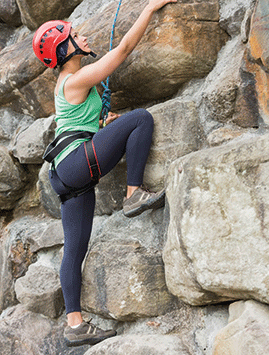5 ways to enjoy the great outdoors

Tired of exercising in the gym? Why not get outside and enjoy the fresh air with our pick of the best outdoor activities
Wild swimming
Fed up of swimming laps around your local swimming pool? You could always take the plunge and try wild swimming; the increasingly popular practice of swimming in natural waters such as rivers, lakes and the sea. Swimming is a great cardiovascular exercise as it works all the main muscle groups simultaneously whilst not putting pressure on the joints. And by shunning your local lido in favour of your local river, you’ll also get the chance to reconnect with nature. The cold temperatures of autumn and winter may put a lot of people off, but you can always opt to wear a wetsuit, silicon hat and maybe even booties and gloves. As with any outdoor activity precautions need to be taken, of course, and there is plenty of safety advice on the Outdoor Swimming Society’s website relating to finding swimming spots that are safe, clean and legal. Also, if you have a heart condition or asthma, it is recommended to see your doctor before taking up swimming outdoors. For more information visit www.outdoorswimmingsociety.com
Canoeing or kayaking
Canoeing or kayaking offers a great opportunity to explore the many waterways in your local area, whilst enjoying the benefits of fresh air and exercise. It also helps to improve your cardiovascular fitness and increases muscle strength, particularly in the back, arms, shoulders and chest plus the torso and legs. If you are a complete novice, you might want to try out one of the starter sessions run by Go Canoeing which are held at clubs and centres around the country and provide the ideal introduction to the sport for both adults and children. The association also runs guided tours designed to help people find new places to go canoeing or kayaking as well as enjoying the social side of these activities. The basic equipment needed includes a boat, paddle and a buoyancy aid but these will most likely be provided for beginners by your local club or centre. In order to stay warm, dry and safe you will also need a wetsuit or a combination of a paddle-top and paddle bottoms, as well as thermals and a sturdy helmet. For more information and tips on finding a local club, visit www.gocanoeing.org.uk
Rock climbing
Rock climbing is an exhilarating sport which can be enjoyed both indoors and outdoors by enthusiasts of all ages. Your back, abdominal and leg muscles will all get a good workout, as will your fingers, shoulders and arms. When practised regularly, rock climbing can help to improve your stamina, flexibility and agility. Your brain will get a good workout too as problem-solving is a big part of this sport. Complete beginners may want to try a taster session or introductory course on an indoor climbing wall rather than heading straight for the nearest crag. Or you could become a member of a climbing, hill walking or mountaineering club or join an outdoor climbing course which will teach you the essential skills. Learning how to belay properly is vital in order to be able to climb safely – this is a technique which involves exerting tension on a climbing rope so that if the climber falls, they remain safe. Equipment needed includes climbing shoes, a harness, belay device, karabiner and ropes. For more information contact the British Mountaineering Council: www.thebmc.co.uk
Horse riding
Horse riding is a fun sport which can be taken up at any age. It will certainly get you fit and will help to strengthen your core muscles whilst toning the stomach and bottom. It is also said to have similar mood-boosting effects to the well-known ‘runner’s high’. A good way for complete novices to get started is to find a local riding school. The British Horse Society (BHS) and the Association of British Riding Schools (ABRS) both set the standards for riding schools, so it’s worth checking their website for approved schools in your area. The types of lessons offered will usually vary from private classes to small groups of two or three people learners or larger groups. The facilities may vary too from outdoor teaching areas to covered or indoor areas. Your local riding school will provide all the equipment you need but before you embark on your first lesson, it’s a good idea to wear practical, sturdy shoes, exercise trousers and layers of breathable clothing that are not too baggy. The riding school should be able to provide you with suitable headwear. For more information visit www.bhs.org.uk or www.abrs-info.org
Outdoor bootcamps
If your ideal form of exercise is more along the lines of a gym workout then you might want to find a local bootcamp in your area. Outdoor bootcamps can be found all across the country and are a great way to get fit, tone up, lose weight and meet new people. Some claim to help you burn around 700 to 800 calories per session. British Military Fitness runs bootcamps in parks at various locations around the UK and for people of mixed abilities. Each session lasts for an hour and includes a warm-up, cardio and strength training, plus a cool down and stretches. All their instructors have military experience and are qualified fitness instructors and personal trainers. A range of equipment and activities are incorporated into the sessions from kettlebells and medicine balls to boxing classes and running, keeping the classes varied and interesting. No special equipment is needed apart from comfortable workout clothes. For more information visit www.britmilfit.com
Read previous Your Outdoor Living articles here...